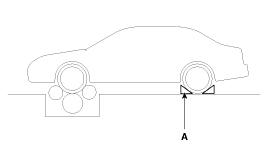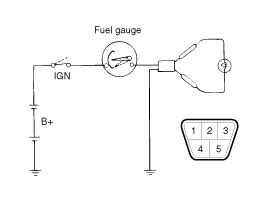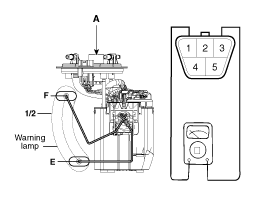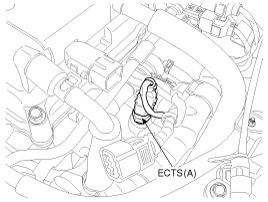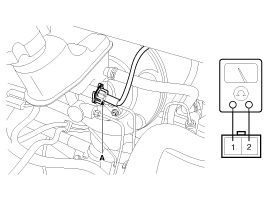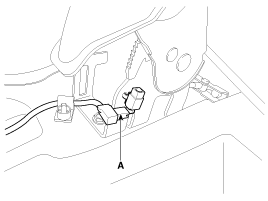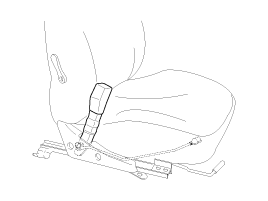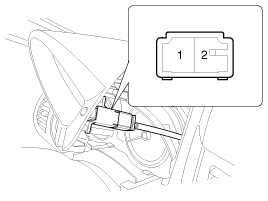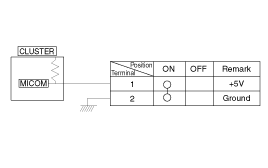 Hyundai Accent: Inspection
Hyundai Accent: Inspection
Speedometer
| 1. |
Adjust the pressure of the tires to the specified level.
|
| 2. |
Drive the vehicle onto a speedometer tester. Use wheel chocks
(A) as appropriate.
|
| 3. |
Check if the speedometer indicator range is within the standard
values.
[km/h]
[MPH]
|
Tachometer
| 1. |
Connect the GDS to the diagnostic link connector or install a
tachometer.
|
| 2. |
With the engine started, compare the readings of the tester with
that of the tachometer. Replace the tachometer if the tolerance is exceeded.
|
Fuel Gauge
| 1. |
Disconnect the fuel sender connector from the fuel sender.
|
| 2. |
Connect a 3.4 watt, 12V test bulb to terminals 1 and 3 on the
wire harness side connector.
|
| 3. |
Turn the ignition switch to the ON, and then check that the bulb
lights up and the fuel gauge needle moves to full.
|
Main Fuel Gauge Sender
| 1. |
Using an ohmmeter, measure the resistance between terminals 1
and 3 of sender connector (A) at each float level.
|
| 2. |
Also check that the resistance changes smoothly when the float
is moved from "E" to "F"
|
| 3. |
If the height resistance is unsatisfied, replace the fuel sender
as an assembly.
|
Engine Coolant Temperature lamp
| 1. |
Disconnect the wiring connector (A) from the engine coolant temperature
sender in the engine compartment.
|
| 2. |
Turn the ignition switch ON. Check that the gauge needle indicates
cool. Turn the ignition switch OFF.
|
| 3. |
Connect a 12V, 3.4 watt test bulb between the harness side connector
and ground.
|
| 4. |
Turn the ignition switch ON.
|
| 5. |
Verify that the test bulb flashes and that the indicator moves
to HOT.
If operation is not as specified, replace the engine coolant temperature
lamp. Then recheck the system.
|
Brake Fluid Level Warning Switch
| 1. |
Remove the connector (A) from the switch located at the brake
fluid reservoir.
|
| 2. |
Verify that continuity exists between switch terminals 1 and 2
while pressing the switch (float) down with a rod.
|
Brake Fluid Level Warning Lamp
| 1. |
Ignition "ON"
|
| 2. |
Release the parking brake.
|
| 3. |
Remove the connector from the brake fluid level warning switch.
|
| 4. |
Ground the connector at the harness side.
|
| 5. |
Verify that the warning lamp lights.
|
Parking Brake Switch
The parking brake switch (A) is a pulling type. It is located under the
parking brake lever. To adjust, move the switch mount up and down with the parking
brake lever released all the way.
| 1. |
Check that there is continuity between the terminal and switch
body with the switch ON (Lever is pulled).
|
| 2. |
Check that there is no continuity between the terminal and switch
body with the switch OFF (Lever is released).
If continuity is not as specified, replace the switch or inspect
its ground connection.
|
Door Switch
Remove the door switch and check for continuity between the terminals.
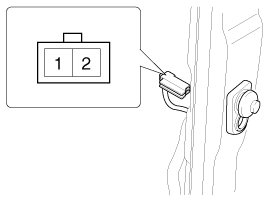

Seat Belt Switch
| 1. |
Remove the connector from the switch.
|
| 2. |
Check for continuity between terminals.
|
Seat Belt Warning Lamp
With the ignition switch turned ON, verify that the lamp glows.
|
Seat belt condition |
Warning lamp |
|
Fastened |
OFF |
|
Not fastened |
ON |
Trip Switch
| 1. |
Disconnect the negative (-) battery terminal.
|
| 2. |
Remove the trip switch (A) from the cluster fascia panel.
|
| 3. |
Check for continuity between the terminals in each switch position
according to the table.
|
 Removal
Removal
1.
Disconnect the negative (-) battery terminal.
2.
Remove the cluster fascia panel (A) after disconnecting the trip
switch connector(B).
...
See also:
Body Control Module (BCM). Specifications
Specifications
Item
Requirement
Remark
Rated voltage
DC 12V
Shall activate normally in these range.
Operat ...
Removal
1.
Remove the ignition key from the vehicle.
2.
Disconnect the battery negative cable and wait for at least three
minutes before beginning ...
Variant coding
After replacing the SRSCM with a new one, must be performed the “Variant
Coding” procedure.
1.
On ...
Hyundai Accent Manuals
- Hyundai Accent 2017-2022 Service Manual
- Hyundai Accent 2010-2025 Owners Manual
- Hyundai Accent 2010-2025 Service Manual
© 2011-2025 Copyright www.hamanual.com

